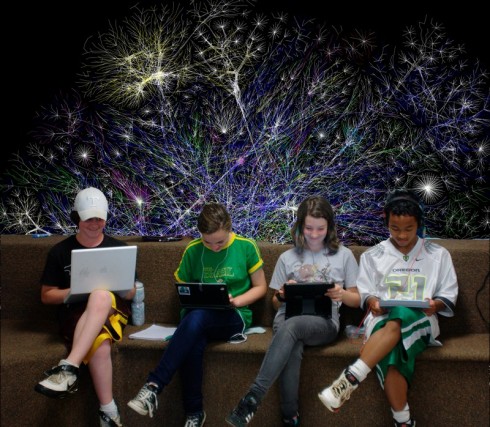
The last re-entry of the space-shuttle was captured from the International Space Station.
Middle and High School … from a Montessori Point of View

The last re-entry of the space-shuttle was captured from the International Space Station.
Perhaps it’s cultural conditioning, or maybe it’s genetic a predisposition, but adolescent boys to seem to have more of a predilection for war games than their female peers. The games they like tend to be first-person-shooters, like Call of Duty, and, given the trends toward improved video game graphics and remote, kinetic military action, real and simulated life seem to be converging.
Recently however, the Stuxnet virus exposed a much less glamorous picture of the future of cyber warfare. Kim Zetter has an excellent, extensive article in Wired on the computer scientists and engineers who reverse engineered the virus to try to figure out who made it and what it did. Since the virus seems to have been aimed at damaging Iran’s nuclear enrichment plants their work brought them to the edge of the world of international espionage. And they still don’t really know who created this remarkably sophisticated virus, though they suspect the U.S. and Israel.
One of the most interesting take-home messages from Zetter’s article is the amazing degree of international collaboration it took to figure things out. The virus was discovered by someone in Belarus. Researchers from the anti-virus company Symantec’s offices in California, Tokyo and Paris worked together passing information from one office to the next to keep the project going 24 hours a day. They published their findings to share them, and when they ran into stumbling blocks they couldn’t solve they put out calls for help on the internet – and people responded, bringing in expertise from Germany and the Netherlands.
The virus’ secretive creators and the open, diverse collaborators who untangled the virus reflect two conflicting aspects of the future that computer technology and the internet are making possible. And this conflict is showing up more and more in different areas – take Wikileaks for example – so it will be very interesting to see where the future takes us. Of course, we are not simply flotsam on the tides of history. As citizens of the internet, we have been enabled. We have a certain power, and a concomitant responsibility, to shape what we have for the benefit of our fellow citizens and those that come after us.
Molly Backes, an author of young adult fiction, considers the question from a mother about her teenager, “She wants to be a writer. What should we be doing?”
Her first answer was, “You really do have to write a lot. I mean, that’s mostly it. You write a lot.”
But then she thought about it, and that’s where it gets really interesting:
First of all, let her be bored. …
Let her be lonely. Let her believe that no one in the world truly understands her. …
Let her have secrets. …
…
Let her fail. Let her write pages and pages of painful poetry and terrible prose. …
Let her make mistakes.
…
Let her find her own voice, even if she has to try on the voices of a hundred others first to do so. …
Keep her safe but not too safe, comfortable but not too comfortable, happy but not too happy.
Above all else, love and support her. …
— Bakes (2011): How to Be a Writer
At the end she posts a picture of her collection of forty-two writer’s notebooks.
It’s a wonderfully written and well considered post that I’d recommend to anyone trying to teach writing and language, particularly if you take the apprentice writer approach. And, I’ve always been a great believer in the power of boredom.
Backes’ advice more-or-less summarizes my interpretation of the Montessori approach: create a safe environment and give students the opportunity to explore and learn, even if it means a certain amount of struggle and failure.

It’s also interesting to note how differently writers and other experts think, yet how much their practices overlap. Mathematician Kevin Houston also recommends writing a lot when he explains how to think like a mathematician, but his objective is to use full, rigorous sentences to clarify hard logic, and less to explore the beauty of the language or discover something profound about shared humanity.
The Story of Stuff is a pretty commonly used video that starts the conversation on resource use and consumerism. The video below, “Full Printed,” takes a look at the future and how technology, particularly 3-D printers, might reduce the environmental costs of the things we use.
FULL PRINTED from nueve ojos on Vimeo.
There are already some places for 3d printing.
The experience of losing our Internet connection becomes more and more like losing a friend.
— Sparrow et al., 2011: Google Effects on Memory: Cognitive Consequences of Having Information at Our Fingertips (pdf).

Last year, my students informed me that humans have a fundamental need for electronics. And I was forced to agree. We’re becoming more inseparable from our devices, practically all of which are connected to the internet. So much so, that people aren’t spending the time memorizing all the stuff they used to memorize, and are instead just remembering where to find it (or what search terms to google).
The results of four studies suggest that when faced with difficult questions, people are primed to think about computers and that when people expect to have future access to information, they have lower rates of recall of the information itself and enhanced recall instead for where to access it. The Internet has become a primary form of external or transactive memory, where information is stored collectively outside ourselves.
— Sparrow et al., 2011: Google Effects on Memory: Cognitive Consequences of Having Information at Our Fingertips (pdf).
Since one of the prime reasons for this blog was to help me remember all the stuff I usually forget (and where to find all the stuff I usually forget), I have to say that these results have the scent of truth. Our cyborgization continues.
So, given this shift to outsourcing our memories, it seems even more imperative that students learn how to think and solve problems, and where to look to find good information they can use in their problem solving, rather than work more on memorization of facts. There are fast becoming too many fact to memorize, and they’re almost all accessible on the internet.
Robert DuGrenier blows glass shells for hermit crabs. They’re pretty amazing. Aquariums are also using them because they let you see all the parts of the crab that are usually hidden inside the shells.
Paul Nicholas Worsey explains the physics and chemistry of how fireworks work. He’s cited in Sophie Bushwick great post compiling online resources that explain the science of fireworks.


NASA has a nice, simple page showing the symbols astronomers use for the major bodies in the solar system and describing what they represent. The symbols are a shorthand that make it easier to take notes and draw diagrams. The Wikipedia page has a lot more detail if you need it.

Alas, despite their long history of use – 2500 years or more – these symbols can be the source of some very adolescent humor, so beware.